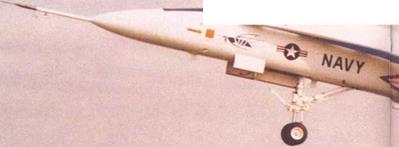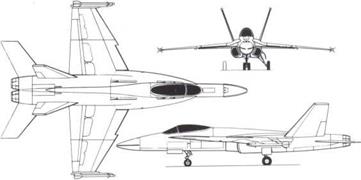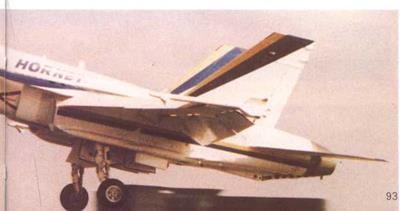McDonnell Douglas/Northrop F-18 Hornet and Cobra
F-18, TF-18 and F-18L
Origin: Original basic design, Northrop Corp: prime contractor, McDonnell Douglas Corp, USA, with Northrop building centre and aft fuselage.
Type: (F) single-seat carrier-based multi-role fighter, (TF) dual trainer, (A) single-seat land-based attack fighter.
Engines: Two 16,0001b (7257kg) thrust General Electric F404-400 two – shaft augmented turbofans.
Dimensions: Span (with missiles) 40ft 8Jin (12 41m), (without missiles) 37ft 6in (11 -42m): length 56ft (17-07m); height 14ft 9Jin (4-50m). Weights: (Provisional) empty 20,583lb (9336kg): loaded (clean) 33.642lb (15,260kg): maximum loaded (catapult limit) 50,064lb (22,710kg). Performance: Maximum speed (clean, at altitude) 1,190mph (1915km/h. Mach 1 -8), (maximum weight, sea level) subsonic: sustained combat manoeuvre ceiling, over 49,000ft (14,935m): absolute ceiling, over 60,000ft (18,290m): combat radius (air-to-air mission, high, no external fuel) 461 miles (741km): ferry range, not less than 2,300 miles (3700km).
Armament: One 20mm M61 Gatling in upper part of forward fuselage: nine external weapon stations for maximum load (catapult launch) of 13,4001b (6080kg), including bombs, sensor pods, ECM, missiles (including Sparrow) and other stores, with tip-mounted Sidewinders.
History: First flight (YF-17) 9 June 1974: (first of 11 test F-18) 18 November 1978: (production F-18) probably late 1980: service entry, planned for 1 982.
User: USA (Navy, Marine Corps).
Development: In 1 971 the US Navy became concerned at the cost of the F-14 and the resulting reduced rate of procurement and total number that could be afforded. In 1973 it studied low-cost versions and compared them with navalised F-15 versions and improved F-4s. In 1 974 the VFX specification emerged for a wholly new and smaller fighter somewhat along the lines of the Air Force Air Combat Fighter. In May 1975 the Navy and Marine Corps announced their choice of the F-18, developed from the existing land-based Northrop F-17 by McDonnell Douglas and Northrop. In fact the F-18 will be almost twice as heavy as the original F-17 proposal but, with more powerful engines, is expected to have adequate dogfight performance through the 1980s. Features include an unswept wing with large dogteeth and forebody strakes at the roots, twin canted vertical tails, simple
Below: Takeoff by the first YF-18 Hornet prototype on 18 November 1978. All 11 flight-test aircraft had flown by 1980 and both land-based and early carrier trials were said to be promising.
|
|
|
Above: Three-view of F-18 Hornet. |
fixed engine inlets and extensive graphite/epoxy structure. Search radar will be used in the interception and surface-attack roles, and a very wide range of weapons will be carried. In the Navy air-superiority mission the gun will be backed up by two Sparrows and two Sidewinders, and the F-18 is expected to show dramatic improvements over the F-4J in manoeuvrability, reliability and low cost. In Marine attack missions the maximum load can be 14,0001b for airfield operation, and the inertial guidance and weaponaiming are expected to offer a significant advance over the accuracy of any A-7. The Navy/Marines plan to buy 11 development aircraft plus 1,366 production machines during the 1980s, the original target price being about $5-9 millidn in 1975 dollars. Originally the Marine Corps version was to be designated A-18, because of its different mission equipment but it was later decided not to produce a dedicated attack version. Instead the Marine F-18 will replace the two Sparrow (or AMRAAM) missiles by a laser spot-tracker on one pylon and a forward-looking infra-red pod on the other. About one aircraft in every 13 will be a dual-control TF-18, with less internal fuel and no head-up display. In addition an RF-18 version has been proposed as a Fleet reconnaissance machine to replace the RF-8G and RA-5C, with a nose basically similar to that of the RF-5E.
In late 1 976 Northrop — original designer of the YF-17 but a mere subcontractor on the F-18 – was trying to relaunch the land-based Cobra, but now as a modified F-18. Despite severe competition from the F-16 and other aircraft. Northrop aims to find worldwide sales for the Cobra replacing the F-4, F-104, A-7 and Mirage. It would have less internal fuel than the F-18, and thus even higher performance. Planned export delivery date is 1983, priced at $8 million in 1975 dollars. This simplified land-based machine is designated F-18L, and is not normally named Plornet. Northrop is prime contractor for this project, which in late 1 979 was being considered by Australia, Canada, Israel and Turkey, among other possible customers.
|
|













